Local trash can cleaning service tackles sanitation and environmental concerns – cbs8.com

Report on Salty Clean’s Contribution to Sustainable Development Goals
Executive Summary
Salty Clean, a San Diego-based enterprise, provides a professional sanitation service for residential trash receptacles. The company’s operational model is designed not only to address household hygiene but also to make significant contributions toward several United Nations Sustainable Development Goals (SDGs), particularly those concerning water quality, sustainable communities, and marine life.
Operational Model and Environmental Safeguards
The service utilizes a self-contained, mechanized system that addresses public health and environmental concerns through a specific process:
- High-Temperature Sanitization: A hot pressure washer heats fresh water to 200°F. This temperature is sufficient to eliminate 99.9% of bacteria present in and on the trash cans.
- High-Pressure Cleaning: A specialized spinning nozzle operating at over 1500 PSI effectively removes stubborn debris from the interior surfaces of the receptacles.
- Wastewater Containment: All contaminated water generated during the cleaning process is captured within the system, preventing runoff into public storm drains.
- Responsible Disposal: The collected wastewater is transported and disposed of at a designated, legally compliant dump site, ensuring it does not pollute local ecosystems.
Alignment with Key Sustainable Development Goals
SDG 6: Clean Water and Sanitation & SDG 14: Life Below Water
Salty Clean’s core value proposition directly addresses targets within SDG 6 and SDG 14.
- Pollution Prevention (Target 14.1): By capturing all contaminated wastewater, the service actively prevents land-based pollutants, including bacteria and chemical residues from waste, from entering the storm drain system and ultimately reaching the ocean. This mitigates a common source of urban runoff pollution that harms marine ecosystems.
- Improving Water Quality (Target 6.3): The company’s practice of responsible wastewater disposal at certified facilities supports the goal of improving ambient water quality by eliminating the release of untreated, contaminated water into the environment.
SDG 11: Sustainable Cities and Communities
The service contributes to creating healthier and more sustainable urban environments in line with SDG 11.
- Improved Urban Sanitation (Target 11.6): By professionally sanitizing waste receptacles, Salty Clean reduces bacteria and foul odors, improving the immediate living environment for residents and contributing to better municipal waste management hygiene.
- Environmental Impact Reduction: The prevention of water contamination is a direct reduction of the adverse per capita environmental impact of the city.
SDG 17: Partnerships for the Goals
The company demonstrates a commitment to SDG 17 by engaging in collaborative efforts within the community.
- Local Collaboration: Salty Clean actively partners with local non-profit organizations in San Diego, fostering community engagement and leveraging its business model for broader social benefit.
Service Structure and Pricing
The company offers several service plans, each including the cleaning of two residential trash cans. A final deodorizing agent is applied post-sanitization.
- Quarterly Service: $60 per quarter
- Bi-Monthly Service: $50 per bi-monthly period
- Monthly Service: $40 per month
Analysis of Sustainable Development Goals (SDGs) in the Article
Which SDGs are addressed or connected to the issues highlighted in the article?
-
SDG 6: Clean Water and Sanitation
- The article’s primary focus is on Salty Clean’s service that prevents “contaminated water from flowing into local waterways.” This directly addresses the goal of ensuring the availability and sustainable management of water and sanitation by tackling a source of water pollution.
-
SDG 14: Life Below Water
- By preventing polluted wastewater from entering storm drains, the service helps protect “the ocean.” This aligns with the goal of conserving and sustainably using the oceans, seas, and marine resources by reducing land-based pollution that harms marine ecosystems.
-
SDG 3: Good Health and Well-being
- The article highlights that dirty trash cans “hold a lot of bacteria.” The company’s cleaning process, which “will kill 99.9% of all the bacteria,” contributes to ensuring healthy lives by improving sanitation and reducing potential sources of illness in the residential environment.
-
SDG 11: Sustainable Cities and Communities
- The service operates in San Diego, addressing an urban environmental issue. By managing the liquid waste from trash can cleaning responsibly, it helps reduce the adverse environmental impact of the city, contributing to making the community more sustainable and environmentally sound.
-
SDG 12: Responsible Consumption and Production
- Salty Clean’s business model promotes the environmentally sound management of waste. By providing a professional service that disposes of contaminated water “properly at a legal dump site,” it encourages a more responsible pattern of household maintenance and waste management.
What specific targets under those SDGs can be identified based on the article’s content?
-
Target 6.3: Improve water quality by reducing pollution
- The article states that the service prevents “contaminated water from flowing into local waterways.” This directly supports the target of improving water quality by reducing pollution and eliminating the dumping of untreated wastewater from residential sources.
-
Target 14.1: Prevent and significantly reduce marine pollution
- The company’s effort to stop contaminated runoff from reaching “the ocean” is a direct action towards reducing marine pollution from land-based activities, which is the core objective of this target.
-
Target 3.9: Substantially reduce illnesses from pollution and contamination
- By using a hot pressure washer that “will kill 99.9% of all the bacteria in and on your cans,” the service helps reduce residential exposure to bacteria and contaminants, thus contributing to the reduction of illnesses from environmental contamination.
-
Target 11.6: Reduce the adverse environmental impact of cities
- The service focuses on a specific aspect of municipal waste management—the sanitation of waste containers and the proper disposal of the resulting wastewater. This helps reduce the overall environmental footprint of the city of San Diego by managing a previously uncontrolled source of pollution.
-
Target 12.4: Achieve the environmentally sound management of chemicals and all wastes
- The company’s process, which includes collecting all wastewater and taking it to a “legal dump site” for proper disposal, exemplifies the environmentally sound management of this specific waste stream, preventing its release into the local environment.
Are there any indicators mentioned or implied in the article that can be used to measure progress towards the identified targets?
-
Indicator for Target 6.3: Proportion of wastewater safely treated
- The article implies this indicator through its description of the business process. The company’s self-contained system collects all contaminated water, which is then taken to a “legal dump site.” This represents a 100% collection and safe disposal rate for the wastewater generated by their service, in contrast to the 0% treatment rate when individuals clean their own cans and let the water run into storm drains.
-
Indicator for Target 14.1: Reduction in pollutants from land-based activities entering marine environments
- An implied indicator is the volume of contaminated water prevented from entering the ocean. Each cleaning service performed by Salty Clean directly prevents a certain amount of polluted water from entering the storm drain system and, subsequently, the ocean. The number of customers served could be a proxy measure for the amount of pollution averted.
-
Indicator for Target 3.9: Reduction in bacterial contamination in the household environment
- The article explicitly provides a performance metric that serves as an indicator: the claim that the 200°F water “will kill 99.9% of all the bacteria in and on your cans.” This quantifies the effectiveness of the sanitation process in reducing a source of potential illness.
Summary of Findings
| SDGs | Targets | Indicators |
|---|---|---|
| SDG 6: Clean Water and Sanitation | Target 6.3: By 2030, improve water quality by reducing pollution, eliminating dumping and minimizing release of hazardous chemicals and materials. | Implied Indicator: Volume of contaminated wastewater collected and disposed of at a “legal dump site” instead of entering local waterways. |
| SDG 14: Life Below Water | Target 14.1: By 2025, prevent and significantly reduce marine pollution of all kinds, in particular from land-based activities. | Implied Indicator: Reduction in contaminated runoff from residential properties reaching the ocean via storm drains. |
| SDG 3: Good Health and Well-being | Target 3.9: By 2030, substantially reduce the number of deaths and illnesses from hazardous chemicals and air, water and soil pollution and contamination. | Mentioned Indicator: The sanitation process kills “99.9% of all the bacteria” in trash cans, reducing a source of household contamination. |
| SDG 11: Sustainable Cities and Communities | Target 11.6: By 2030, reduce the adverse per capita environmental impact of cities, including by paying special attention to… municipal and other waste management. | Implied Indicator: Implementation of a professional service for managing liquid waste byproducts from residential solid waste containers. |
| SDG 12: Responsible Consumption and Production | Target 12.4: By 2020, achieve the environmentally sound management of chemicals and all wastes throughout their life cycle… and significantly reduce their release to… water and soil. | Implied Indicator: The proportion of waste (contaminated water) from trash can cleaning that is managed in a controlled, self-contained system. |
Source: cbs8.com
What is Your Reaction?
 Like
0
Like
0
 Dislike
0
Dislike
0
 Love
0
Love
0
 Funny
0
Funny
0
 Angry
0
Angry
0
 Sad
0
Sad
0
 Wow
0
Wow
0



















































.jpg.webp?itok=0ZsAnae9#)
























